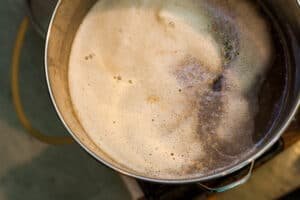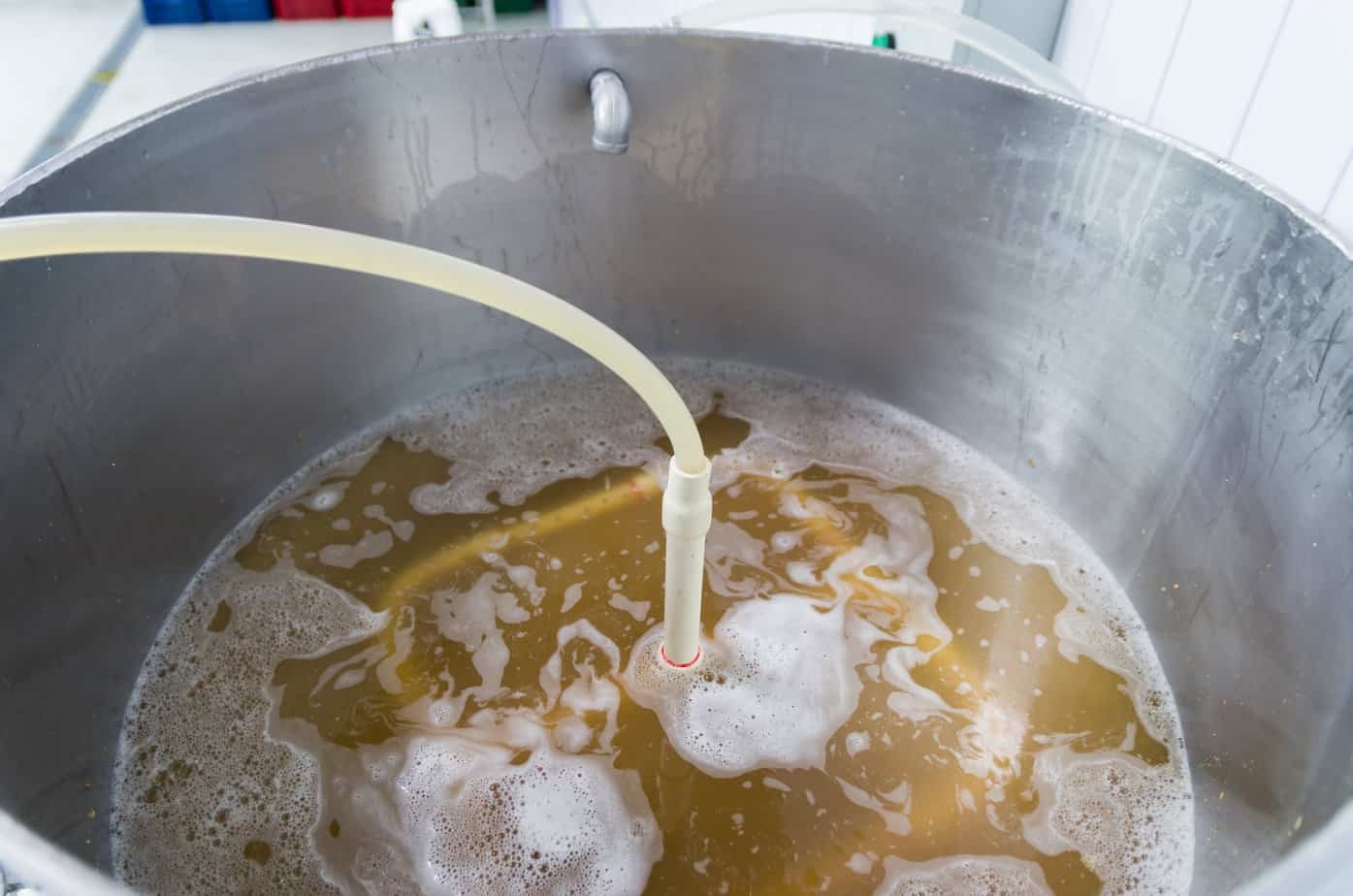As homebrewers, you often have to weigh maximizing your brewing output against reducing waiting time. One method to increase yield is sparging, which can be timeous and alter your flavor profile. To avoid having problems bubble up during your brew, we can tap from the knowledge and experience of brewers, professionals, and homebrewers.
Homebrewers may choose not to sparge their mash, trading efficiency for ease and fuller body. Sparging grain delivers more sugars for fermentation and increases brew yield, while not sparging is less time-consuming but requires more grain at the outset.
The process of sparging is usually down to the brewer’s preference. Homebrewers may find that they are less constrained by economic considerations, so they can invest in more materials for their brew in exchange for specific characteristics. Intrepid brewers may need to consider the merits of sparging versus not sparging, the consequences of not sparging, and how to maximize output.
What Is The Point Of Sparging?
At the initial stages of brewing, hot water is used to steep and hydrate barley, activate the malt enzymes in the grain, and convert grain starches into fermentable sugars. Only after this mashing process can the grain bed can be sparged. Sparging spreads the water evenly over the grain bed using a sparge arm so that the maximum amount of sugar can be obtained while limiting the concentration of bitter tannins.
The next step in the brewing process involves adding brewing yeast, which requires the nutrients from the sugar in your wort to ferment your beer. The goal of sparging is thus to maximize the number of nutrients available for fermentation, which allows you to make more (and higher quality) beer.
Benefits of sparging your brew:
- Your brewing efficiency increases due to better extraction of sugars for the fermentation process.
- The quality of your brew increases as fermentable sugars increase your flavor profile.
- The grain bill of a sparged brew is reduced compared to not sparging. No-sparge methods require a higher number of grains present before mashing starts to achieve the same level of gravity and volume.
- You can predict the quality of your beer beforehand as less sugar is lost in the brewing process.
- Sparging is less space-intensive than no-sparging methods, meaning you do not require as much room for equipment or gigantic containers.
However, there are some potential downsides to sparging, which include the risk of over-sparging. When you sparge your mash excessively, the gravity of the beer (the density of the sugars available for fermentation) decreases. Your beer may become bitter as the pH increases with successive sparges, leading to tannin release into the wort.
The sparging method chosen can determine the taste profile of your brew and the amount of beer produced at the end. The most common approaches to sparging are continuous sparging (fly sparging), batch-sparging, and even avoiding sparging altogether.
What Happens If You Don’t Sparge?
The advantages and disadvantages of sparging will influence whether a brewer chooses to sparge their mash or not. Sparging helps increase the sugar levels in a brew while decreasing the necessary grain for brewing. The downside is that the pH of the mixture rises with repeated sparging, potentially producing quite a bitter beer should too many tannins be extracted into the wort.
When you don’t sparge, the risk of tannins influencing the flavor of your brew decreases, but you obtain less beer from the same amount of grain. To compensate for the reduction in yields, brewers often produce more mash, which means you add more brewing liquor and will need a large mash tun.
The no-sparge brewing technique requires about 25% more grain in the mash. Still, because no sparging is necessary, it is less important to monitor the pH of the mash. Not sparging the mash means the beer isn’t diluted, and the process is significantly faster.

Does Sparging Increase Efficiency?
Sparging helps brewers obtain maximum yield from their process and improves the flavor of the wort. Particularly with fly sparging, better extractions result at the end of the process. Brewers have relied on continuous sparging their beer for centuries to deliver tastier beer at greater volumes.
Depending on the proficiency of the brewer, the sparging method used, and how finely the grains are ground pre-mash, homebrewers can attain efficiency levels of up to 95% sugar extraction. Higher efficiency reduces your grain budget and increases the productivity of the yeast you will add later.
Fly sparging (continuous sparging) has been observed to be the most efficient method, regularly achieving efficiency upwards of 85%, while batch-sparging usually reaches 75%. Higher levels can be reached by also using methods that ensure constant temperature adherence and prevent wort loss. It would be best to refrain from using grains crushed too finely or too finely.
Do You Sparge With Brew In A Bag?
Brewing in a bag is another option where sparging occurs in batches or is omitted entirely. With the entire grain contents in a fine-mesh bag, your mash involves steeping the bag in boiling water before removing it and boiling the kettle further. The choice is up to the brewer whether they wish to sparge or not to sparge or squeeze the mash bag.
Typically, the bag containing the mash is hoisted over the wort, with the bottom remaining in contact with the brewing liquid below. Gently squeezing the bag will help drain excess wort and extract more sugars. Typically, with homebrewing in a bag, it is unnecessary to sparge. If the brewer decides to sparge the grains, any wort left in the bag is then rinsed from the mash contents with sparging water.
This process is less efficient than continuous sparging. Still, it is much simpler and accessible to novice homebrewers or those on a budget. On a commercial scale, however, the added efficiency obtained from sparging makes thousands of dollars of difference. So, those few mass-scale bag brewers tend to sparge to maximize sugar extraction.
Can I Sparge With Cold Water?
Sparging is best done at higher temperatures of around 168°F to 170°F. At these temperatures, the sugars in the mash will be easier to rinse from the grains, and the enzymes breaking down the starch in the grain are less active. Consequently, the number of tannins extracted into your brew is limited.
However, it is possible to sparge with comparatively cold water (e.g., tap water, but not chilled water). The consequences of sparging with colder water are that you may fail to achieve the strength of alcohol you were aiming for when you started brewing. There may also be substantial amounts of sugar left in the mashed grains.
This option may become attractive if you lack access to the required equipment or are unconcerned about the number of sugars you obtain. You can do a few tests at various temperatures for a novice starting the process from scratch. Observing the different outcomes of different brewing methods and ingredients may be illuminating.
Conclusion
When brewing at home, you may be tempted to skip the sparging step as it is more accessible, and the downsides don’t seem too severe. The potential drawbacks of not sparging include a higher grain requirement and a potentially smaller yield due to limited sugar extraction. The choice is up to each brewer whether they prefer the ease of not sparging or the increased volume and quality of beer resulting from extra time and effort.
Recent Posts
Does Bud Light Seltzer Taste Like Beer? - Unveiling the Flavor Profile
The popularity of hard seltzers has risen dramatically in recent years, with an increasing number of consumers seeking a lighter, refreshing alternative to traditional alcoholic beverages. Bud Light...
How to Flavor Moonshine with Extract: Tips and Tricks for a Delicious Batch
Moonshine, a homemade distilled spirit, has a reputation for its strong flavor and robust alcohol content. Many people find the taste too harsh to enjoy on its own, which is why flavoring moonshine...

